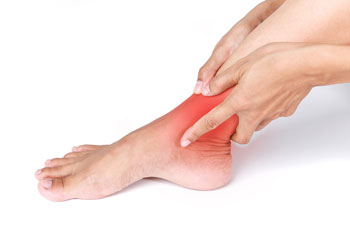
Ankle Pain Treatment in North Texas
Ankle pain can result when the ankle is twisted or turned in an awkward manner and the ligaments are forced to move beyond their normal range of movement. Ankle pain may also result from several different types of conditions. Injuries of the ankle bones, tendons and ligaments can cause ankle pain. Several different types of arthritis can lead to ankle pain.
Causes of Ankle Pain
Ankle pain can be caused by injury and several other conditions. People who engage in sports such as football, running, jogging, are at higher risk of sustaining an ankle injury. Though ankle injuries are common causes of ankle pain, there are many other medical conditions that may cause ankle pain. These include:
- Achilles tendinitis
- Achilles tendon rupture
- Avulsion fracture
- Broken foot
- Bursitis
- Gout
- Osteoarthritis
- Osteochondritis dissecans
- Plantar fasciitis
- Pseudogout
- Psoriatic arthritis
- Reactive arthritis
- Rheumatoid arthritis
- Septic arthritis
- Sprained ankle
- Stress fractures
- Tarsal tunnel syndrome
Symptoms of ankle pain include:
- Stiffness
- Swelling
- Discoloration
- Redness
- Warmth
- Tenderness
- Throbbing
- Instability
- Bruising
- Abnormal or restricted movement
- Looseness of the joint
Diagnosis
Your podiatrist will review your medical history and conduct a physical examination to ascertain the cause of the pain. If the pain was caused by an injury, you may be asked to stand or walk around the room to help your doctor determine the extent of damage. If the pain is caused by arthritis or other medical conditions, your doctor may conduct imaging scans such as X-ray to ascertain the severity of the condition.
Ankle Pain Treatment
Ankle pain treatment depends on the cause and severity of the pain. Mild ankle pain can be treated using home remedies while severe ankle pain requires professional medical treatments.
Home Remedies
If you have a mild ankle injury or pain, you can simply treat yourself at home. You can use the R.I.C.E approach (rest, ice, compression, elevation) for treatment as outlined in the Achilles injury treatment section.
Medications
In most cases, over-the-counter pain relievers such as ibuprofen (Advil, Motrin IB, others) or naproxen sodium (Aleve, others) or acetaminophen (Tylenol) are enough to relieve the pain. In case of swelling or inflammation, anti-inflammatory medications can be given to reduce it.
Support Devices
You may need supports to decrease the weight applied to the ankle. This will help relieve pain and promote quicker healing. Your primary care physician may prescribe an elastic bandage, sports tape or ankle support to stabilize the ankle. If you have severe sprain, a cast or walking boot might be needed to immobilize the lower leg while the ligament heals.
Physical Therapy
When pain is reduced enough to continue movement, you may need to begin exercises or physical activities in order to restore your ankle’s range of motion, flexibility, strength and stability. Your primary care physician or a physical therapist will suggest the best and most appropriate exercises and physical activities for you. Stability and balance training are essential for retraining your ankle muscles to effectively support the joint and help avoid additional sprains. If you sprained your ankle while practicing or competing in a sport, ask your primary care physician when you can resume. Physical therapy programs and exercises are an important part of the recovery process for strengthening your ankle.
Surgery
Surgery is required in rare cases when the ankle is not responding to other conservative treatment options. We may perform surgery to repair a ligament that won’t heal, or to reconstruct the ligament.
We repair fractures with casting to immobilize the bone to promote healing. Depending on severity, fractures can require orthopedic casting or surgical procedures such as pinning and open repair of the fractured bone.
A car accident can lead to severe ankle injury such as dislocation of the ankle joint. Ankle dislocation is a serious injury. An ankle dislocation generally requires surgical repair.
Prevention
Ankle injuries can be prevented. Sports activities and accidental trauma are common causes of ankle injuries. To prevent ankle injuries and pain:
- Avoid activities that have higher tendencies of causing injury to your ankle.
- Follow proper sport instructions and physical training to avoid or minimize the risk of an ankle injury or pain
- Use ankle braces or supports to shield your ankle from injury
- Engage in flexibility exercises to strengthen the ankle
- Avoid high-impact exercises that cause strain to the ankle
- Wear good support shoes and socks to shield the ankle from external objects
- Avoid physical activities that increase the risk of ankle injury
- If you have arthritis or any other medical condition, follow your doctor’s advice to prevent a severe ankle injury and pain
